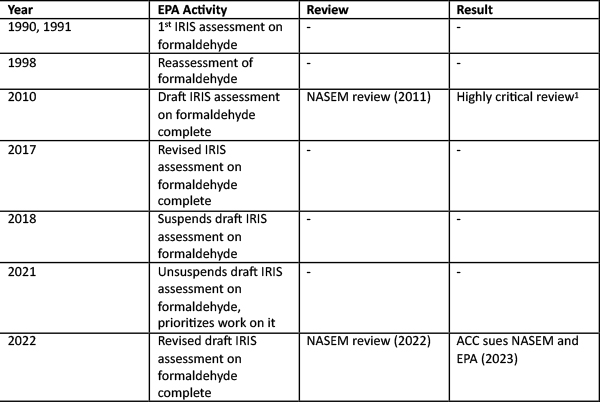On July 20, the American Chemistry Council (ACC), the principal trade association for the chemical industry in the U.S., sued the EPA and the National Academies of Sciences, Engineering, and Medicine (NASEM) over the EPA’s 2022 draft IRIS Assessment on Formaldehyde. Lawsuits against the EPA are not unique, but those including NASEM are another story.
Background
Formaldehyde is one of the most important building blocks in manufacturing. It is a reactive intermediate in many chemical processes, with little or no formaldehyde remaining in the final product. It is used in:
- Agriculture: fertilizers, herbicides, and a disinfectant for seeds.
- The automotive industry: components for the interior, paints, brake pads, and fuel systems.
- Building and construction: plywood, particleboard, fiberboard, furniture and paneling, insulation and flooring, and kitchen cabinets.
- Health and hygiene: as preservatives in personal care products and soaps and detergents.
- Medicine: as a preservative in medical laboratories, in vaccines, and to make medical devices such as heart valves and prostheses.
- Aerospace: to make polyurethane foams for airplane seats and cabin floors, and cargo liners.
The EPA has been working on assessing the toxicity and health impacts of formaldehyde for over 30 years. [1] Governmental agencies regularly contract with nonprofit institutions, such as NASEM, to review complex scientific issues. NASEM, chartered in 1863 by President Lincoln, “are private, nonprofit institutions that provide independent, objective analysis and advice to the nation to solve complex problems and inform public policy decisions related to science, engineering, and medicine.”
Formaldehyde Issues
The issue is not whether formaldehyde should be regulated, as it has for decades, but whether science supports revising the current regulations or proposing new limits. Formaldehyde causes respiratory effects at high levels, from nose and throat irritation to asthma-related conditions—however, most of the controversy centers on cancer. Scientific assessments have concluded that formaldehyde only poses a cancer risk at high levels, not lower ones found in the environment.
“[there is] evidence that formaldehyde inhalation causes nasopharyngeal cancer, sinonasal cancer, and myeloid leukemia in exposed humans given appropriate exposure circumstances.”
- EPA’s 2022 Formaldehyde Integrated Risk Information System (IRIS) [2]
However, the IRIS document does not outline “the appropriate exposure circumstances” for formaldehyde to cause cancer, resulting in ambiguity as to formaldehyde’s safe level. Failure to define a clear, safe level for cancer leaves the door open for “acceptable” formaldehyde levels so low that it is no longer economically feasible for essential products.
The ACC Lawsuit
The two laws that the ACC claims that EPA and NASEM violated are the Federal Advisory Committee Act (FACA) and the Administrative Procedure Act (APA). Both laws aim to provide transparency and a clear process that allows for public input in the rulemaking process.
The ACC claims improper EPA control over the NASEM review violated the Federal Advisory Committee Act (FACA). FACA requires that members of federal advisory committees be “fairly balanced” in views represented and that “the advice and recommendations of the advisory committee not be inappropriately influenced by the appointing authority or by any special interest but will instead be the result of the advisory committee’s independent judgment.” [3]
I have written about the importance of the APA in setting the drinking water regulations for the “forever chemicals .”The APA requires that federal agencies provide a review period for the public to submit comments on proposed rules and that all rules be published in the Federal Register.
The ACC claims that because EPA violated FACA, EPA is prohibited by the APA from “arbitrarily and capriciously” relying on the report issued by NASEM, the IRIS Toxicological Assessment on Formaldehyde.
The ACC lawsuit asserts that NASEM violated FACA by:
- Failing to ensure a fair and balanced committee. – The committee is not balanced technically, lacking expertise in several critical scientific disciplines crucial to a robust and complete review. The committee lacks any scientists with expertise in private-sector industrial toxicology and epidemiology; scientists uniquely posed to consider the real-world usage of formaldehyde. Industry experts should be included on the panel because industry will be directly affected by the final assessment.
- Not allowing for a reasonable opportunity for public input regarding committee appointments.
- Allowing EPA to exercise impermissible control over the committee. – The EPA told NASEM which scientists should be on the committee and prohibited the committee from reviewing materials other than the assessment and documents submitted by EPA.
- Ignoring relevant information from sources outside the EPA. – After NASEM’s 2010 formaldehyde assessment, the ACC undertook a scientific research project to help address the data needs identified by NASEM. Over 50 peer-reviewed publications authored by individuals affiliated with the ACC were part of that research project. However, EPA ignored a significant portion of that research in their 2022 assessment. When the ACC attempted to provide the publications to NASEM, they were rebuffed, with NASEM saying that their charge was solely based on materials presented by the EPA.
The ACC lawsuit claims that EPA violated FACA by impermissibly controlling who was on the committee, and the issues allowed for discussion - only considering EPA’s view of the evidence. During “open sessions” to solicit public comment on scientific matters, NASEM stated that its true goal is “to engage in a question-and-answer session with EPA” and that “the committee’s view is that the sponsor, EPA, is best positioned to …. answer questions on the assessment of formaldehyde.”
The ACC lawsuit concludes that “unreliable reports on formaldehyde promoted by the federal government create concrete and particularized injuries to members of ACC that regularly use the chemical to create products that modern society is dependent upon. [posing] unjustifiable hurdles and restrictions on all companies that use formaldehyde”.
The record shows that the ACC has attempted to communicate extensively with the EPA and NASEM since 2011 and has received limited responses. I believe that this is due to the perception by the EPA that conflict of interest exists only for industry. They fail to “see” that selecting Advisory committee members with a long history of concurring with EPA is a conflict. This is the heart of the issue that FACA was trying to avoid.
Are these laws simply check-the-box activities, or do federal agencies need to implement them as they were intended, i.e., to provide real public input and diverse opinions on rulemaking that has the potential to affect the lives of every American?
[1] 
1 “EPA’s draft assessment was not prepared in a logically consistent fashion, lacks clear links to an underlying conceptual framework and does not sufficiently document methods and criteria used to identify evidence for selecting and evaluating studies.”
[2] IRIS is the EPA’s database summarizing EPA’s essential health information on chemicals and is used additionally by States, local governments, industry, and academia.
[3] Other requirements include that each advisory committee meeting be open to the public, detailed minutes be kept of all meetings, and that working drafts, studies, or other documents prepared by or presented to the advisory committee be made available to the public.

